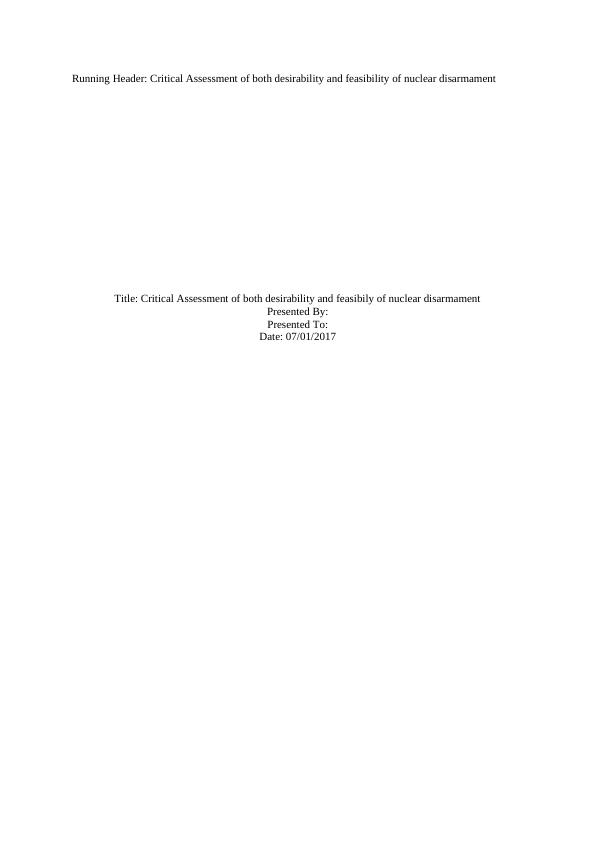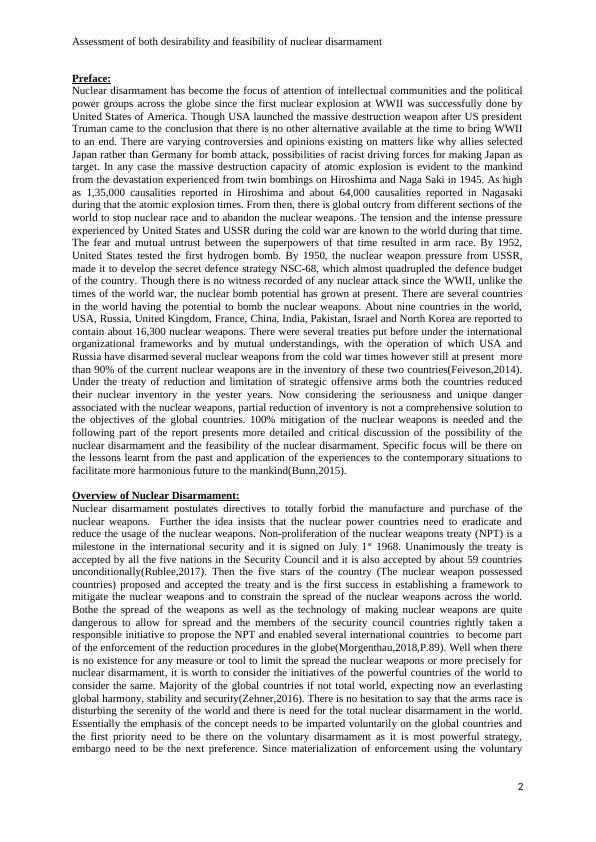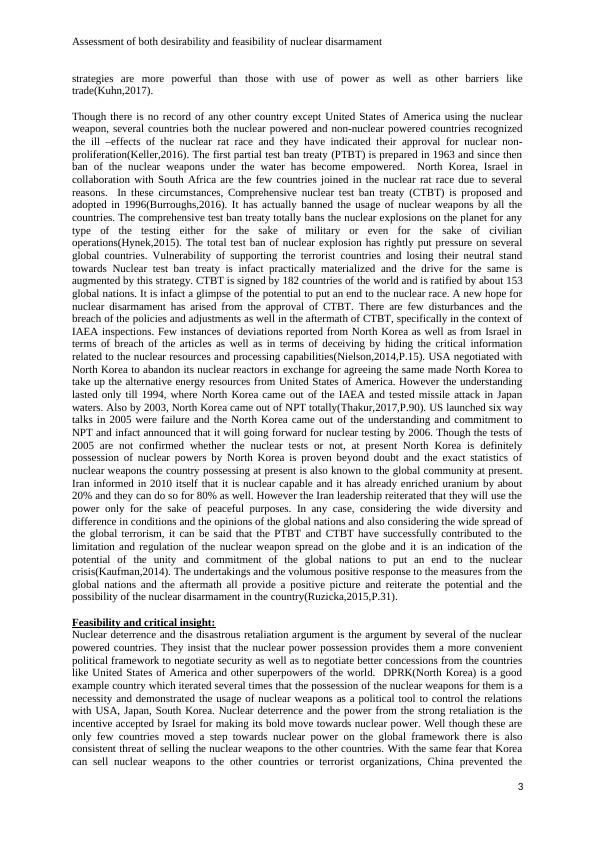Critical Assessment of both desirability and feasibility of nuclear disarmament
Added on 2020-05-28
6 Pages3004 Words42 Views
Running Header: Critical Assessment of both desirability and feasibility of nuclear disarmamentTitle: Critical Assessment of both desirability and feasibily of nuclear disarmamentPresented By:Presented To:Date: 07/01/2017

Assessment of both desirability and feasibility of nuclear disarmamentPreface:Nuclear disarmament has become the focus of attention of intellectual communities and the politicalpower groups across the globe since the first nuclear explosion at WWII was successfully done byUnited States of America. Though USA launched the massive destruction weapon after US presidentTruman came to the conclusion that there is no other alternative available at the time to bring WWIIto an end. There are varying controversies and opinions existing on matters like why allies selectedJapan rather than Germany for bomb attack, possibilities of racist driving forces for making Japan astarget. In any case the massive destruction capacity of atomic explosion is evident to the mankindfrom the devastation experienced from twin bombings on Hiroshima and Naga Saki in 1945. As highas 1,35,000 causalities reported in Hiroshima and about 64,000 causalities reported in Nagasakiduring that the atomic explosion times. From then, there is global outcry from different sections of theworld to stop nuclear race and to abandon the nuclear weapons. The tension and the intense pressureexperienced by United States and USSR during the cold war are known to the world during that time.The fear and mutual untrust between the superpowers of that time resulted in arm race. By 1952,United States tested the first hydrogen bomb. By 1950, the nuclear weapon pressure from USSR,made it to develop the secret defence strategy NSC-68, which almost quadrupled the defence budgetof the country. Though there is no witness recorded of any nuclear attack since the WWII, unlike thetimes of the world war, the nuclear bomb potential has grown at present. There are several countriesin the world having the potential to bomb the nuclear weapons. About nine countries in the world,USA, Russia, United Kingdom, France, China, India, Pakistan, Israel and North Korea are reported tocontain about 16,300 nuclear weapons. There were several treaties put before under the internationalorganizational frameworks and by mutual understandings, with the operation of which USA andRussia have disarmed several nuclear weapons from the cold war times however still at present morethan 90% of the current nuclear weapons are in the inventory of these two countries(Feiveson,2014).Under the treaty of reduction and limitation of strategic offensive arms both the countries reducedtheir nuclear inventory in the yester years. Now considering the seriousness and unique dangerassociated with the nuclear weapons, partial reduction of inventory is not a comprehensive solution tothe objectives of the global countries. 100% mitigation of the nuclear weapons is needed and thefollowing part of the report presents more detailed and critical discussion of the possibility of thenuclear disarmament and the feasibility of the nuclear disarmament. Specific focus will be there onthe lessons learnt from the past and application of the experiences to the contemporary situations tofacilitate more harmonious future to the mankind(Bunn,2015).Overview of Nuclear Disarmament:Nuclear disarmament postulates directives to totally forbid the manufacture and purchase of thenuclear weapons. Further the idea insists that the nuclear power countries need to eradicate andreduce the usage of the nuclear weapons. Non-proliferation of the nuclear weapons treaty (NPT) is amilestone in the international security and it is signed on July 1st 1968. Unanimously the treaty isaccepted by all the five nations in the Security Council and it is also accepted by about 59 countriesunconditionally(Rublee,2017). Then the five stars of the country (The nuclear weapon possessedcountries) proposed and accepted the treaty and is the first success in establishing a framework tomitigate the nuclear weapons and to constrain the spread of the nuclear weapons across the world.Bothe the spread of the weapons as well as the technology of making nuclear weapons are quitedangerous to allow for spread and the members of the security council countries rightly taken aresponsible initiative to propose the NPT and enabled several international countries to become partof the enforcement of the reduction procedures in the globe(Morgenthau,2018,P.89). Well when thereis no existence for any measure or tool to limit the spread the nuclear weapons or more precisely fornuclear disarmament, it is worth to consider the initiatives of the powerful countries of the world toconsider the same. Majority of the global countries if not total world, expecting now an everlastingglobal harmony, stability and security(Zehner,2016). There is no hesitation to say that the arms race isdisturbing the serenity of the world and there is need for the total nuclear disarmament in the world.Essentially the emphasis of the concept needs to be imparted voluntarily on the global countries andthe first priority need to be there on the voluntary disarmament as it is most powerful strategy,embargo need to be the next preference. Since materialization of enforcement using the voluntary2

Assessment of both desirability and feasibility of nuclear disarmamentstrategies are more powerful than those with use of power as well as other barriers liketrade(Kuhn,2017).Though there is no record of any other country except United States of America using the nuclearweapon, several countries both the nuclear powered and non-nuclear powered countries recognizedthe ill –effects of the nuclear rat race and they have indicated their approval for nuclear non-proliferation(Keller,2016). The first partial test ban treaty (PTBT) is prepared in 1963 and since thenban of the nuclear weapons under the water has become empowered. North Korea, Israel incollaboration with South Africa are the few countries joined in the nuclear rat race due to severalreasons. In these circumstances, Comprehensive nuclear test ban treaty (CTBT) is proposed andadopted in 1996(Burroughs,2016). It has actually banned the usage of nuclear weapons by all thecountries. The comprehensive test ban treaty totally bans the nuclear explosions on the planet for anytype of the testing either for the sake of military or even for the sake of civilianoperations(Hynek,2015). The total test ban of nuclear explosion has rightly put pressure on severalglobal countries. Vulnerability of supporting the terrorist countries and losing their neutral standtowards Nuclear test ban treaty is infact practically materialized and the drive for the same isaugmented by this strategy. CTBT is signed by 182 countries of the world and is ratified by about 153global nations. It is infact a glimpse of the potential to put an end to the nuclear race. A new hope fornuclear disarmament has arised from the approval of CTBT. There are few disturbances and thebreach of the policies and adjustments as well in the aftermath of CTBT, specifically in the context ofIAEA inspections. Few instances of deviations reported from North Korea as well as from Israel interms of breach of the articles as well as in terms of deceiving by hiding the critical informationrelated to the nuclear resources and processing capabilities(Nielson,2014,P.15). USA negotiated withNorth Korea to abandon its nuclear reactors in exchange for agreeing the same made North Korea totake up the alternative energy resources from United States of America. However the understandinglasted only till 1994, where North Korea came out of the IAEA and tested missile attack in Japanwaters. Also by 2003, North Korea came out of NPT totally(Thakur,2017,P.90). US launched six waytalks in 2005 were failure and the North Korea came out of the understanding and commitment toNPT and infact announced that it will going forward for nuclear testing by 2006. Though the tests of2005 are not confirmed whether the nuclear tests or not, at present North Korea is definitelypossession of nuclear powers by North Korea is proven beyond doubt and the exact statistics ofnuclear weapons the country possessing at present is also known to the global community at present.Iran informed in 2010 itself that it is nuclear capable and it has already enriched uranium by about20% and they can do so for 80% as well. However the Iran leadership reiterated that they will use thepower only for the sake of peaceful purposes. In any case, considering the wide diversity anddifference in conditions and the opinions of the global nations and also considering the wide spread ofthe global terrorism, it can be said that the PTBT and CTBT have successfully contributed to thelimitation and regulation of the nuclear weapon spread on the globe and it is an indication of thepotential of the unity and commitment of the global nations to put an end to the nuclearcrisis(Kaufman,2014). The undertakings and the volumous positive response to the measures from theglobal nations and the aftermath all provide a positive picture and reiterate the potential and thepossibility of the nuclear disarmament in the country(Ruzicka,2015,P.31).Feasibility and critical insight:Nuclear deterrence and the disastrous retaliation argument is the argument by several of the nuclearpowered countries. They insist that the nuclear power possession provides them a more convenientpolitical framework to negotiate security as well as to negotiate better concessions from the countrieslike United States of America and other superpowers of the world. DPRK(North Korea) is a goodexample country which iterated several times that the possession of the nuclear weapons for them is anecessity and demonstrated the usage of nuclear weapons as a political tool to control the relationswith USA, Japan, South Korea. Nuclear deterrence and the power from the strong retaliation is theincentive accepted by Israel for making its bold move towards nuclear power. Well though these areonly few countries moved a step towards nuclear power on the global framework there is alsoconsistent threat of selling the nuclear weapons to the other countries. With the same fear that Koreacan sell nuclear weapons to the other countries or terrorist organizations, China prevented the3

End of preview
Want to access all the pages? Upload your documents or become a member.
Related Documents
Post World War II Nuclear Arms Racelg...
|11
|3315
|183
Cold War and Its Causeslg...
|6
|1416
|115
The Atomic Bombing: Effects of Radiation on People in Hiroshima and Nagasakilg...
|14
|716
|148
Noble Use of Nuclear Energylg...
|4
|780
|50
Significant Events that Changed the Worldlg...
|4
|1123
|468
The Triumph of Idealism: Perspectives on the Second World War and International Relationslg...
|11
|3221
|377
